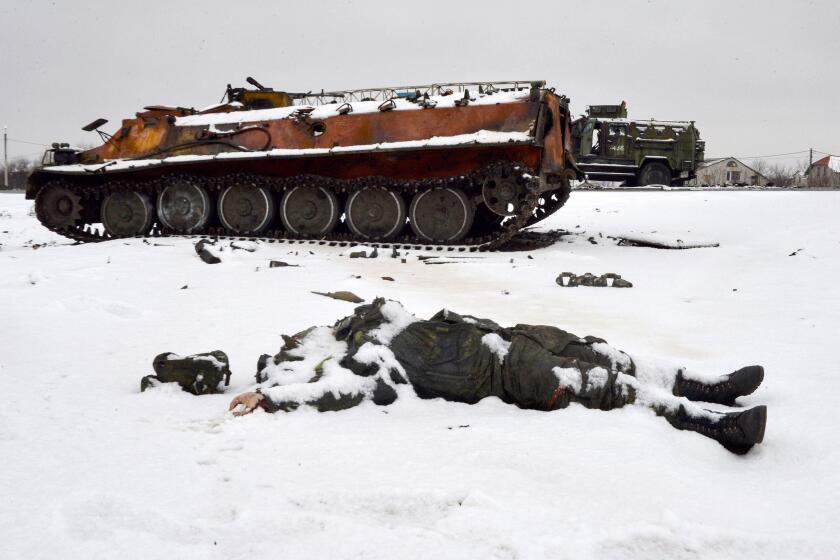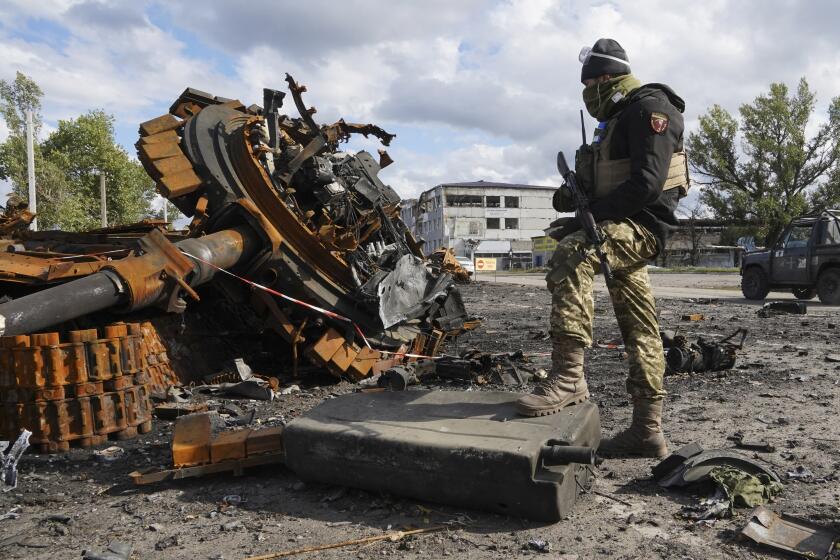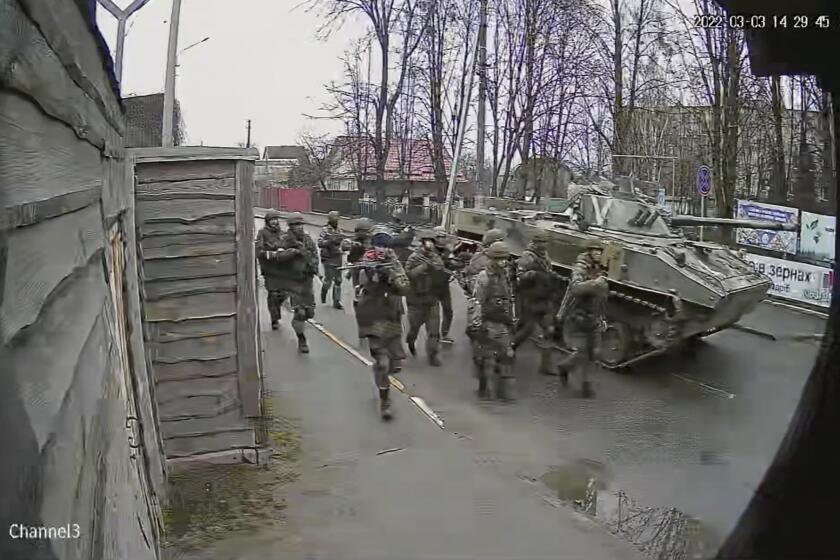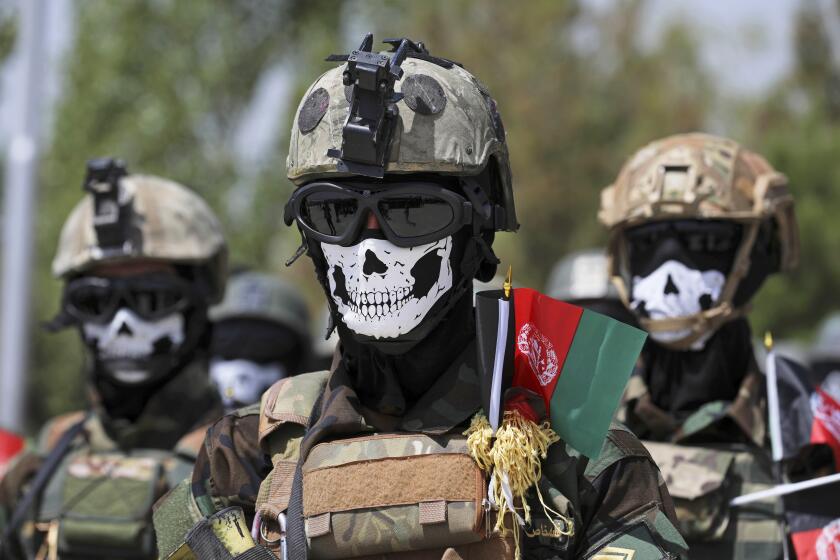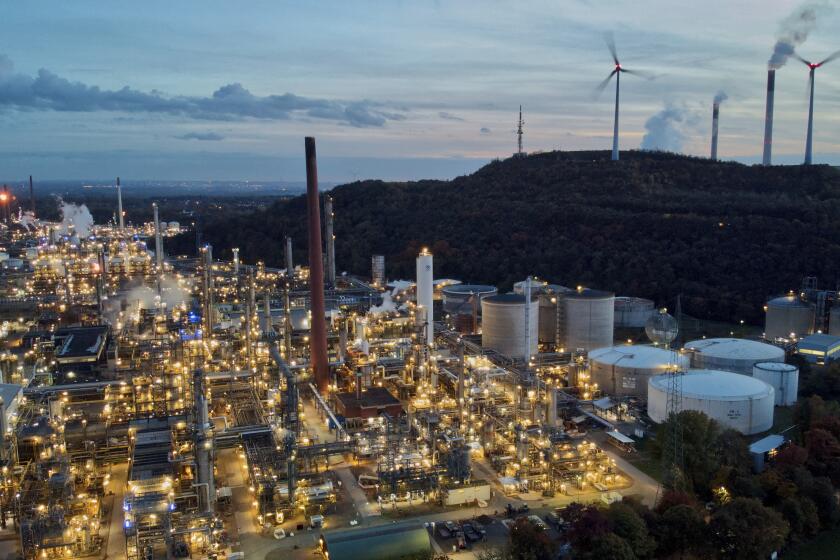U.N. inspectors find no evidence of Ukraine preparing a ‘dirty bomb’ attack on itself, as Russia claims
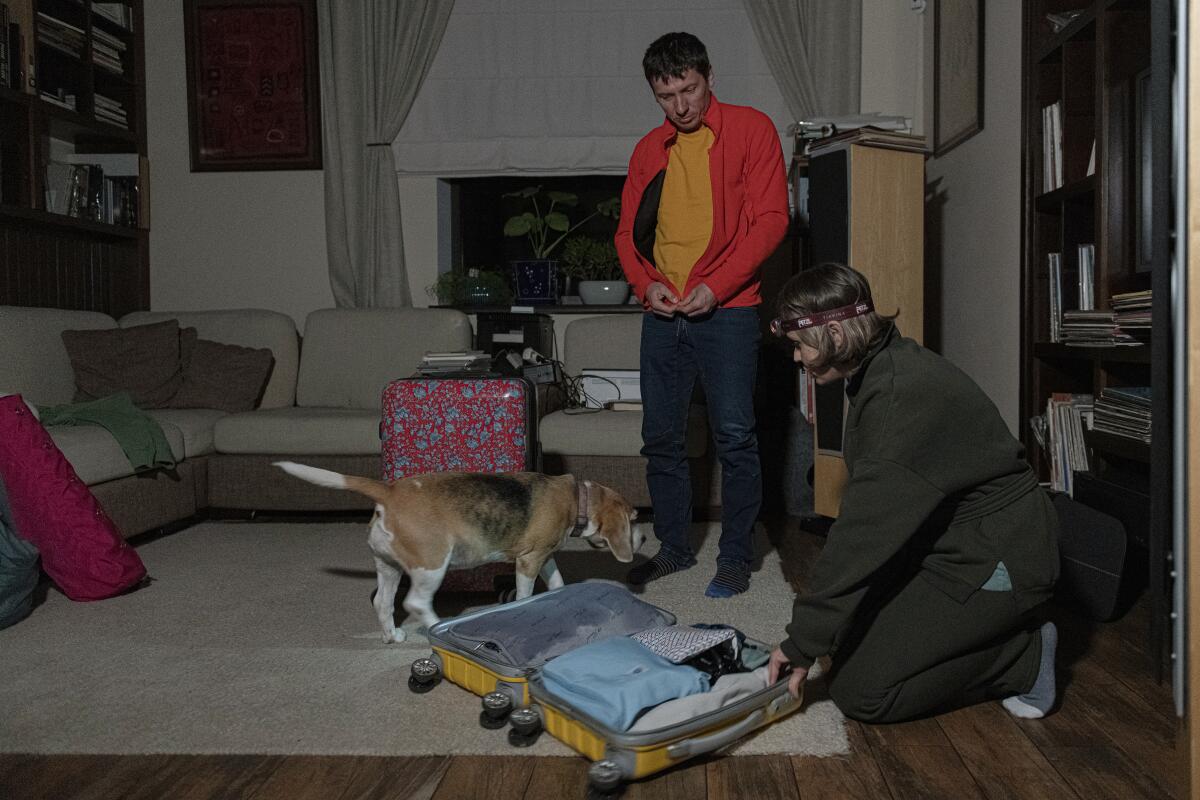
- Share via
KYIV, Ukraine — Experts from the United Nations’ nuclear power agency inspected two sites in Ukraine on Tuesday where Russia has alleged without evidence that Ukrainian authorities planned to set off radioactive “dirty bombs” in their own invaded country.
Russian strikes targeting eight regions of southeastern Ukraine killed at least four civilians and wounded four others in 24 hours, the Ukrainian president’s office said. Tens of thousands of people faced power blackouts and water shortages after Russian shelling of energy infrastructure in 10 regions on Monday.
Rafael Grossi, director-general of the International Atomic Energy Agency, said the inspections for evidence of a so-called dirty bomb, requested by Kyiv in the wake of the unsubstantiated Russian allegations, would be completed soon.
In the wake of battlefield setbacks for Russia in Ukraine, top Russian officials, including President Vladimir Putin, made the accusations that Ukraine was manufacturing an explosive device to scatter radioactive waste. The Russians claimed that the Ukrainians planned to make the purported bomb look like Russia’s doing.
Russia’s U.N. ambassador, Vassily Nebenzia, alleged in a letter to Security Council members last week that Ukraine’s nuclear research facility and mining company “received direct orders from [President Volodymyr] Zelensky’s regime to develop such a dirty bomb.”
Western nations have called Moscow’s repeated claim “transparently false.” Ukrainian authorities dismissed it as an attempt to distract attention from Moscow’s own alleged plans to detonate a dirty bomb as a way to justify a further escalation of hostilities.
Two Siberian journalists reporting on the war in Ukraine say they won’t be muzzled. ‘This is what we are supposed to do.’
The IAEA has said the investigated sites “are under IAEA safeguards and have been visited regularly by IAEA inspectors” whose mission is to detect undeclared nuclear activities and materials related to the development of dirty bombs.
“The IAEA inspected one of the two locations a month ago and no undeclared nuclear activities or materials were found there,” the agency said in a statement Monday.
The U.N. watchdog also has had on-site monitors at the Russian-occupied Zaporizhzhia nuclear power plant. Fighting near Europe’s largest nuclear power station has created worries of a possibly catastrophic radioactive leak.
Zelensky’s office said Tuesday that cities and towns around the plant experienced more heavy shelling between Monday and Tuesday. In Nikopol, a city facing the plant across the wide Dnieper River, more than a dozen apartment buildings, a kindergarten and various private businesses were damaged, the office said.
As Russia’s military performance weakens, a notorious mercenary group, long part of the Ukraine fight, steps into spotlight.
Russian shelling hit 14 towns and villages in the eastern Donetsk region Monday and into Tuesday, destroying sections of railway track, damaging a power line and taking down mobile communications in some areas. A missile also struck the city of Kramatorsk, which hosts the Ukrainian army’s headquarters.
The shelling killed three civilians and wounded three others, the region’s governor, Pavlo Kyrylenko, said. Donetsk is one of four regions illegally annexed by Moscow last month, and continues to see fierce clashes as Russian forces press their grinding attack on the cities of Bakhmut and Avdiivka.
Another woman was killed after Russian rockets slammed into apartment buildings and a school in the southern city of Mykolayiv, its mayor reported Tuesday.
Ukraine was still grappling Tuesday with the consequences of Monday’s massive barrage of Russian strikes, which disrupted power and water supplies in multiple Ukrainian cities and villages.
When Russian troops crossed from Belarus into Ukraine in late February, pressing toward Kyiv, they were ordered to block and destroy ‘nationalist resistance.’
Kyiv Mayor Vitali Klitschko said that authorities restored electricity and running water in the capital’s residential buildings but that rolling power outages would continue because of significant power shortages.
Kyiv regional Gov. Oleksiy Kuleba said Tuesday that 20,000 apartments remained without power.
“Russia has opened an energy front and is using energy to blackmail the civilian population, provoking hunger and cold in Ukraine,” Kuleba said on TV.
Ukraine’s state energy company, Ukrenergo, said in a statement Tuesday that seven regions would experience rolling blackouts “to reduce the load on the [energy] grid, maintain a stable balance within the system and avoid repeated failures.”
Afghan special forces soldiers who were trained by the U.S. and fled after the U.S. withdrawal are being recruited by Russia to fight in Ukraine.
In Kharkiv, Ukraine’s second-largest city, subway service was suspended again Tuesday, according to the subway’s Telegram page. No reason for the suspension was given.
In the occupied Kherson region, Russian-installed authorities sought to evacuate up to 70,000 more people living within nine miles of the Dnieper River in anticipation of a Ukrainian counteroffensive pushing deeper into the region. The effort was already underway Tuesday morning, according to the Kremlin-appointed governor of the region, Vladimir Saldo.
In Russia, the regular fall draft got underway Tuesday, with a total of 120,000 men expected to be conscripted within the next two months. Russian military officials have assured that conscripts will not be sent to fight in Ukraine, including to the annexed regions.
This year’s fall draft was scheduled to start in October but was delayed by one month because of the partial mobilization of 300,000 men, which was declared completed Monday. Kremlin critics have warned that the call-up could resume after the fall draft is over and military enlistment offices are freed from processing conscripts.
The global energy crisis triggered by Russia’s invasion of Ukraine is causing long-lasting changes that have the potential to hasten the transition to a more sustainable and secure energy system, according to a report.
Russian Defense Minister Sergei Shoigu said Tuesday that, of the 300,000 men drafted in the partial call-up announced by Putin on Sept. 21, 87,000 were deployed to Ukraine. Some 3,000 military instructors with combat experience acquired this year in Ukraine are involved in training draftees, Shoigu said.
Activists and reports by Russian media and the Associated Press said many of the mobilized reservists were inexperienced, were told to procure basic items such as medical kits and flak jackets themselves, and did not receive training before they were sent off to fight. Some were killed within days of being called up.
More to Read
Sign up for Essential California
The most important California stories and recommendations in your inbox every morning.
You may occasionally receive promotional content from the Los Angeles Times.
